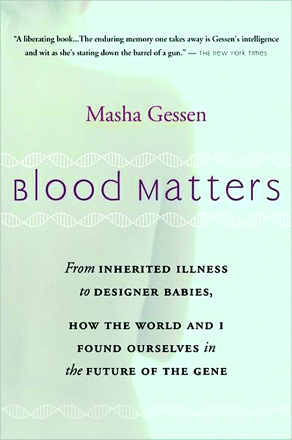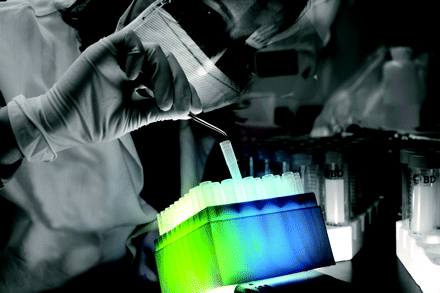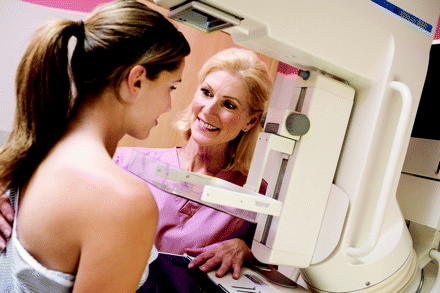Embedded in the Front Lines of Genetics
- Tanya Jelacic, PhD

Blood Matters: From Inherited Illness to Designer Babies, How the World and I Found Ourselves in the Future of the Gene. Masha Gessen. Orlando, Florida: Harcourt; 2008. 321 pages. $15.00. ISBN: 9780151013623
Reporters and scientists have one major characteristic in common, an imperative to investigate. Masha Gessen’s Blood Matters is an investigation into the field of human genetics and its current and future applications. Gessen is a journalist whose work has appeared in Slate, Seed, the New Republic, and the New York Times. Some portions of Blood Matters were previously published in Slate and Granta. However, the writing of Blood Matters was not instigated by an editor; this assignment came from her own DNA. In 2004, Gessen found out that she carries a BRCA1 mutation, which means that the breast cancer that killed her mother will very likely kill her as well. With this knowledge came a tremendous decision: whether or not to have a prophylactic mastectomy and/or oophorectomy. Like any good journalist, or indeed any good scientist, Gessen dealt with her quandary by setting off on a quest for all available data.

Fittingly, because it is about the dawning of the era of personalized medicine, Blood Matters is a deeply personal book. Gessen lays bare her family history of cancer and her struggles with deciding on a course of treatment. She is very frank about the aftermath of surgery, though not unduly graphic. The nerve-rattling sounds of an MRI remind her of the gunfire she heard as a war correspondent although for her, the clear-cut danger of the war zone would be preferable to the “fuzzy” risks of “the life of a genetic mutant.” In an attempt to normalize her situation, Gessen sought out other BRCA mutation carriers and also spent time visiting families carrying a variety of genetic illnesses including inherited gastrointestinal cancers and Huntington’s disease plus maple syrup urine disease (MSUD) and other rare recessive diseases. These families have an onerous inheritance, and their stories can be heartwrenching to read; however, with recent advances in genetic testing there is hope of escape or treatment. Some will find freedom from the family curse by testing negative for the mutation. Others will find themselves in the same boat as Gessen, looking at surgery as a way to avoid a particular death. And for some with metabolic disorders, salvation can be found through the early introduction of specialized diets.
In addition to visiting the sufferers of genetic illnesses, Gessen also consulted with the doctors and scientists who study them. Several of the scientists she interviewed come off as oddballs and are described with cliched stereotypes. “ [Holmes] Morton looked like a country doctor should look…. He wore a gray tweed jacket, a blue oxford button-down shirt with noticeably frayed cuffs, and a bow tie,” while “Erik Puffenberger looked like what a scientist should look like…. [T]he young, anal, collected, type…to whom you would entrust the mapping of your child’s genome.” Richard Ebstein describes himself to her as “fairly autistic, in the way of many scientists.” No disrespect is meant; this is simply how Gessen found them. Her book gives the careers of these dedicated and pioneering scientists well-deserved public recognition. These scientists are not household names, but their work has had a tremendous impact in certain populations. Dr. Henry Lynch was considered crazy by his peers when he first started writing (in 1966) about “cancer family syndrome” and began promoting prophylactic surgeries to prevent cancer (in the 1980s). Hereditary cancer is now dogma, and prophylactic surgery is on its way to becoming a standard of care. Morton started operating the Clinic for Special Children out of his car in 1989. It now operates out of its own building, with state-of-the-art equipment donated by Affymetrix. These stories recount dedication that has saved and changed lives.

One of the biggest revelations of Blood Matters is that the people who have wholeheartedly embraced genetic testing are not necessarily the people one would expect to do so. Ironically, it is two of the most orthodox and conservative societies in the US, the Hasidic Jews of New York and the Old Order Mennonites of Lancaster County, Pennsylvania, that are at the forefront of genetic testing. These are both closed societies, in which recessive disorders frequently appear, and societies which place a high premium on health. According to Jewish law, a person should not marry one with whom he or she would produce sickly children. The Old Order Mennonites value work, faith, and community. They reject modern advances like television that can distract from their core values, but they utilize modern medicine to preserve their health and thus sustain their core values. How genetic testing is conducted is particular to each culture. The Hasidic group Dor Yeshorim is a “matchmaking” service unlike any other. Dor Yeshorim tests individuals for carrier status for a variety of recessive conditions such as Tay-Sachs, Canavan, and Niemann-Pick but does not inform any of those tested of their status. A prospective couple submits their Dor Yeshorim ID numbers and gets an answer regarding their compatibility based upon whether they share any recessive disease genes. Dor Yeshorim has turned out to be remarkably effective. The Kingsbrook Jewish Medical Center in Brooklyn used to have a sixteen-bed Tay-Sachs unit with a waiting list; it closed a decade ago. The Old Order Mennonites were approached by curious and eager geneticists and cooperated fully and willingly, providing blood, urine, and tissue samples and erecting the Clinic for Special Children’s building.
Gessen is not a scientist, but she is a good writer and investigator, and her book is written to serve a broad audience. Principles of genetics, such as the concepts of genetic drift and founder effect, are clearly and knowledgeably explained. There is an appendix, with a glossary of key terms for the non-scientist, and with references for the original research papers for those (most likely scientists) who would like to dig deeper. Gessen’s interest, however, is clearly not in the nuts-and-bolts science of genetics. For her, “DNA testing equipment tends to fall into two categories: things that look like printers and things that look like toasters.” Gessen’s interest in the science of genetics is the human angle: what are the utilities and ramifications of genetic discoveries? She goes beyond the issue of genetic illness to delve into using genetics as a means of self-discovery via ethnicity testing and behavioral genetics. Indeed, the genetic confirmation of the oral tradition of the Cohanim is particularly interesting, and the chapter on behavioral genetics is very thought-provoking.
Blood Matters is a book with many stories to tell. It is a chronicle of one woman’s journey from diagnosis to treatment, but it is also a cultural study of matchmaking among the Hasidic Jews of New York, and the story of some pioneering scientists’ careers. It is a book to provoke gratitude for the genetic hand you’ve been dealt and one that dares you to envision a future in which severe genetic illness will simply no longer occur.
- Copyright © 2010



